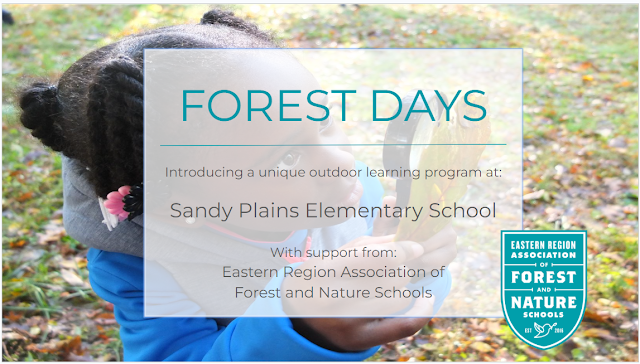Forest Days: Planning
My Title 1 school in Maryland has the unique opportunity to participate with the Eastern Region Association for Forest and Nature Schools (ERAFANS) to host their Forest Days program with our kindergarten students. ERAFANS has previously worked with a Title 1 school in Philadelphia, but this will be their first partnership with a public school in Baltimore County, Maryland. ERAFANS was awarded an $8,000 grant that is being used to fund the program for our school. This money will be used to cover the cost of materials, gear, and a facilitator. Our school is a registered Community School, so we are identifying ERAFANS as our community partner.
 |
Figure 1 Forest Days introduction slide for our parent presentation. |
All four kindergarten classes at our school will participate, using the green space on our school property, or neighboring wild spaces within walking distance, to develop environmental literacy and an appreciation for our natural environment (Eastern Region Association of Forest and Nature Schools [ERAFANS], n.d.). Often, teachers who work in urban areas may feel that they do not have access to natural environments to share with their students (Jacobi-Vessels, 2013). A walk through the neighborhood, around the school grounds, or to a neighborhood park will provide ample opportunities for students to interact with and experience nature. In our urban school community, we could experience the weather, clouds, birds, squirrels, insects, plants, and trees just by walking outside.
 |
Figure 2 A duck walking on the blacktop near our school playground. |
Students will be engaged in learner-centered experiences to develop their social-emotional, language and literacy, and physical developmental skills (ERAFANS, n.d.). Students will build independence and confidence as they participate in outdoor learning. Using an interdisciplinary approach allows teachers and students to meet content standards through outdoor learning experiences in STEM, science, math, literacy, and art.
Nature play and exploration can be an effective way to teach across the curriculum (Jacobi-Vessels, 2013). With the Forest Days model nature play provides hands-on experiences to help children build their naturalistic intelligence and learn about local animals, insects, plants, and trees. These opportunities can be linked to classroom content and standards and help students connect science or math skills to the real world (Goldstein et al., 2018). As they build their knowledge from these experiences they begin to make more sense of the world and have a better understanding of everyday phenomena. One of our science units is about squirrels and the phenomena that surround the squirrel's everyday interactions in our neighborhood.
As our kindergarten team approaches the beginning of our Forest Days journey, we take a little bit of time to consider the guiding principles that will move us through this experience with our students. In the photo graphic below, the 12 guiding principles are like our compass to ensure that we as educators are moving in the right direction to best support our students. Our engagement in this experience matters, too (Jacobi-Vessels, 2013). We play an important role in helping our students feel safe, comfortable, and connected in the outdoors. To play that role, we too must have a positive attitude and model what it looks like to step out of our comfort zone, be curious, and take risks.
 |
Figure 1 Forest Days Guiding Principles Note. Eastern Region Association for Forest and Nature Schools. (n.d.). Forest Day Guiding Principles [Photograph]. https://www.erafans.org/Forest-Days |
One of my goals is to use this blog to share our Forest Days journey. I want to inspire other teachers to step outside the box and be different. Taking learning outside is not what most of us are used to (Larimore, 2014). We know that children learn best through hands-on, authentic experiences. We understand that when children have opportunities to interact with the real world and real-world items, they make more relevant connections. But, most of us have not been trained in this type of pedagogy and it can make us feel anxious to even know where to start. With the support of an organization like ERAFANS, teachers can be trained and discover ways to incorporate creative and innovative ideas in their own classrooms and outdoor learning environments. If you are interested in learning more about the Forest Days program, please visit the ERAFANS website for more information: https://www.erafans.org/Forest-Days .
Eastern Region Association for Forest and Nature Schools. (n.d.). Forest
pigeons: Learning about nature in cities. Young Children, 73(5).
outside the classroom. Dimensions of Early Childhood, 41(3), 4-10.
nature-preschool practices to elementary schools. Natural Start Alliance. https://naturalstart.org/feature-stories/growing-children-bringing-nature-preschool-practices-elementary-schools


Comments
Post a Comment